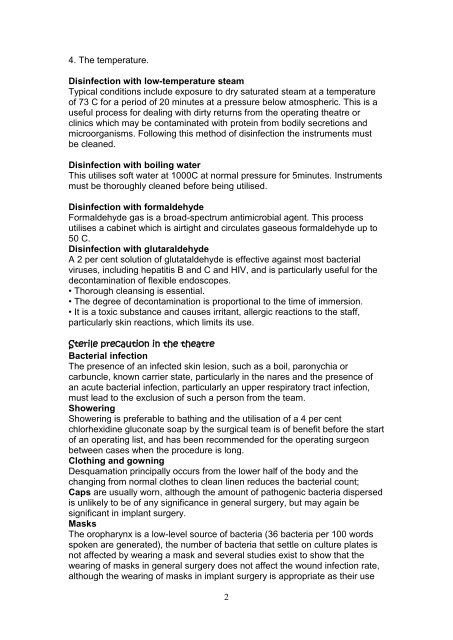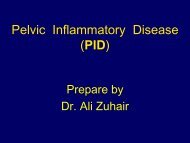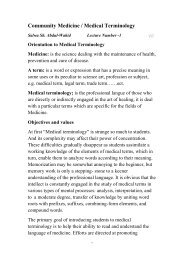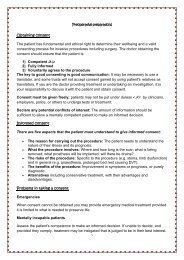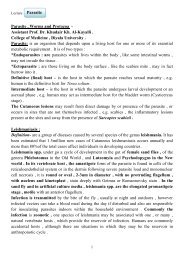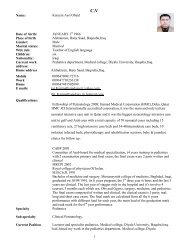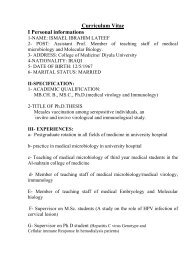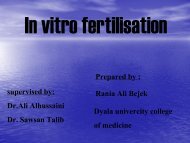Sterilization, disinfection and sterile precaution
Sterilization, disinfection and sterile precaution
Sterilization, disinfection and sterile precaution
Create successful ePaper yourself
Turn your PDF publications into a flip-book with our unique Google optimized e-Paper software.
4. The temperature.<br />
Disinfection with low-temperature steam<br />
Typical conditions include exposure to dry saturated steam at a temperature<br />
of 73 C for a period of 20 minutes at a pressure below atmospheric. This is a<br />
useful process for dealing with dirty returns from the operating theatre or<br />
clinics which may be contaminated with protein from bodily secretions <strong>and</strong><br />
microorganisms. Following this method of <strong>disinfection</strong> the instruments must<br />
be cleaned.<br />
Disinfection with boiling water<br />
This utilises soft water at 1000C at normal pressure for 5minutes. Instruments<br />
must be thoroughly cleaned before being utilised.<br />
Disinfection with formaldehyde<br />
Formaldehyde gas is a broad-spectrum antimicrobial agent. This process<br />
utilises a cabinet which is airtight <strong>and</strong> circulates gaseous formaldehyde up to<br />
50 C.<br />
Disinfection with glutaraldehyde<br />
A 2 per cent solution of glutataldehyde is effective against most bacterial<br />
viruses, including hepatitis B <strong>and</strong> C <strong>and</strong> HIV, <strong>and</strong> is particularly useful for the<br />
decontamination of flexible endoscopes.<br />
• Thorough cleansing is essential.<br />
• The degree of decontamination is proportional to the time of immersion.<br />
• It is a toxic substance <strong>and</strong> causes irritant, allergic reactions to the staff,<br />
particularly skin reactions, which limits its use.<br />
Sterile <strong>precaution</strong> in the theatre<br />
Bacterial infection<br />
The presence of an infected skin lesion, such as a boil, paronychia or<br />
carbuncle, known carrier state, particularly in the nares <strong>and</strong> the presence of<br />
an acute bacterial infection, particularly an upper respiratory tract infection,<br />
must lead to the exclusion of such a person from the team.<br />
Showering<br />
Showering is preferable to bathing <strong>and</strong> the utilisation of a 4 per cent<br />
chlorhexidine gluconate soap by the surgical team is of benefit before the start<br />
of an operating list, <strong>and</strong> has been recommended for the operating surgeon<br />
between cases when the procedure is long.<br />
Clothing <strong>and</strong> gowning<br />
Desquamation principally occurs from the lower half of the body <strong>and</strong> the<br />
changing from normal clothes to clean linen reduces the bacterial count;<br />
Caps are usually worn, although the amount of pathogenic bacteria dispersed<br />
is unlikely to be of any significance in general surgery, but may again be<br />
significant in implant surgery.<br />
Masks<br />
The oropharynx is a low-level source of bacteria (36 bacteria per 100 words<br />
spoken are generated), the number of bacteria that settle on culture plates is<br />
not affected by wearing a mask <strong>and</strong> several studies exist to show that the<br />
wearing of masks in general surgery does not affect the wound infection rate,<br />
although the wearing of masks in implant surgery is appropriate as their use<br />
2


